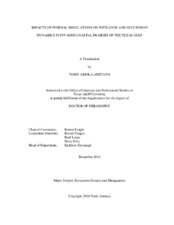| dc.description.abstract | It is unclear if impacts to jurisdictional wetlands in the United States are mitigated commensurately to ensure that the no net loss goal of the Clean Water Act is being met. Similarly, the effect of judicial interpretation and ruling is not clear on the status of regulatory jurisdiction. Therefore, this study sought to answer these questions by mining data from the regulatory agency responsible for regulating wetlands - the US Army Corps of Engineers.
Data was obtained in nine watersheds adjoining the Texas Gulf Coast. In addition, data was obtained from the Galveston District Army Corps of Engineers three years before and three years after the Rapanos’ Supreme Court ruling to determine the effect of the ruling on jurisdictional wetlands.
The Texas Gulf Coastal Prairies (TXGCP) is home to the Texas Coastal Prairie Wetlands, which serve several ecological functions relative to navigable waters. Invasion of Chinese tallow tree, an exotic woody invasive species has threatened the TXGCP so that the original grassland ecosystem has shifted in composition to woody plants, therefore, we seek what ecological process is occurring during invasion. A study was conducted within the TXGCP ecosystem in LaMarque, Texas, using point pattern analysis, Ripley’s-K Function to examine the spatial distribution of tallow relative to native species.
A net deficit is observed across all nine watersheds examined for all dredge and fill activities, structural installation and removal activities occurring in wetlands. It was also determined that the standard permitting mechanism is the only mode of authorization where net gain is achievable. The standard permitting mechanism is the least permitting instrument used for authorization, therefore, a net loss of waters of the United States prevails. In addition, results show that following the Rapanos’ Supreme Court ruling, a greater burden of proof is required from regulatory agencies to ascertain jurisdiction over a wetland, consequently, more wetlands are exempt from permitting. Finally, a trend of secondary succession is found within the coastal prairies due to native shrub species such as wax myrtle and yaupon strategically outcompeting Chinese tallow tree under the competitive exclusion model of secondary succession. | en |


